Exhibits
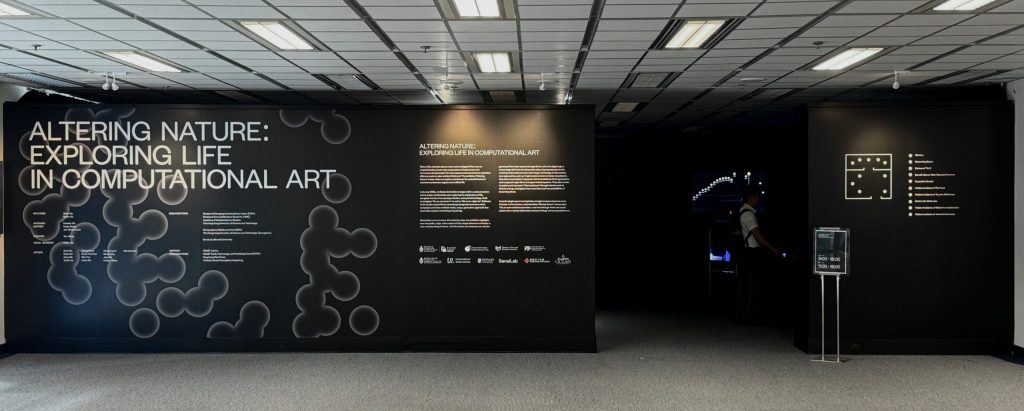
Mimicry
Artists: Ziwei Wu, Wanchao Su
Acknowledgment: Lingdong Huang
Year: 2024
Materials: Flowers, Cameras, Screens, Raspberry Pi, Generative Adversarial Network
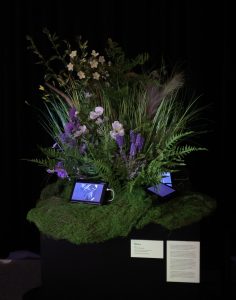 Mimicry is a multi-screen video installation powered by computer algorithms and inspired by mimicry in nature—the unique way species protect themselves by changing color and pattern in response to their environment.
Mimicry is a multi-screen video installation powered by computer algorithms and inspired by mimicry in nature—the unique way species protect themselves by changing color and pattern in response to their environment.
This mimicry behavior is also relevant to human society. As Walter Lippmann describes in his book Public Opinion, people construct a pseudo-environment that is a subjective, biased, and necessarily abridged mental image of the world. To some degree, everyone’s pseudo-environment is a fiction.
In this experimental art piece, cameras will record plants in real-time, and through a computer algorithm, the pattern and texture of virtual insects will be generated and evolved, with the ultimate goal of visually blending into the recorded background. The pattern and texture are produced by the generator, trying to synthesize a new appearance similar to the environment. The discriminator tries to distinguish between the synthetic appearance and the real environment, which plays the role of predators in the adversarial evolution.
The installation setup is an homage to Nam June Paik’s TV Garden. Paik imagined a future landscape where technology is an integral part of the natural world. We find that perspective compelling even today, and it’s an interesting combination to add ALife creatures incorporating AI into the landscape after 50 years.
Becoming Space
Artists: Xinyu Ma, Hengyu Meng, Ziwei Wu
Acknowledgment: Zeyu Wang
Year: 2024
Materials: 3D printing material (polylactic acid), 3D generative AI algorithm, Single-channel video
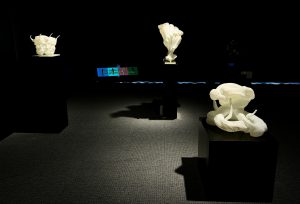 Becoming Spaces explores a series of transformations between humans and animals drawing inspiration from Ovid’s Metamorphoses. This work, comprising sculptures and video, reflects on how this transformation reshapes the relationships between humans and animals. Drawing on Deleuze and Guattari’s concept of “becoming-animals,” those myths reveal that these transformations are processes in which individuals amplify their existing powers and identities or gain new capacities through becoming animals.
Becoming Spaces explores a series of transformations between humans and animals drawing inspiration from Ovid’s Metamorphoses. This work, comprising sculptures and video, reflects on how this transformation reshapes the relationships between humans and animals. Drawing on Deleuze and Guattari’s concept of “becoming-animals,” those myths reveal that these transformations are processes in which individuals amplify their existing powers and identities or gain new capacities through becoming animals.
Deleuze and Guattari also argue that the becoming process is related to collectives and communities. Humans becoming animals always appear in the form of a collective. The collective is an assemblage of sensations and forces, which in turn influence the characteristics of those individuals. The relationships between humans and animals have changed nowadays. As Azuma Hiroki points out, this relationship has generated new features of “animality” and “database”.
By integrating generative AI techniques, we use the Score Distillation Sampling method to guide the deformation of the original 3D model based on the text information. The 3D generative AI models used in the artwork are active participants in the process of transformation, reflecting on the complex relationship as a continuous process of becoming between human and non-human beings that are influenced by digital technologies.
Echoes of Tai O
Artists: Danlu Fei, Xinyu Ma, Ziwei Wu
Acknowledgment: Kam Kwai Wong, Hong Kong Red Cross, A Plastic Ocean Foundation Hong Kong
Year: 2024
Materials: Keyboard Controller, Screens, Reinforcement Learning Agents
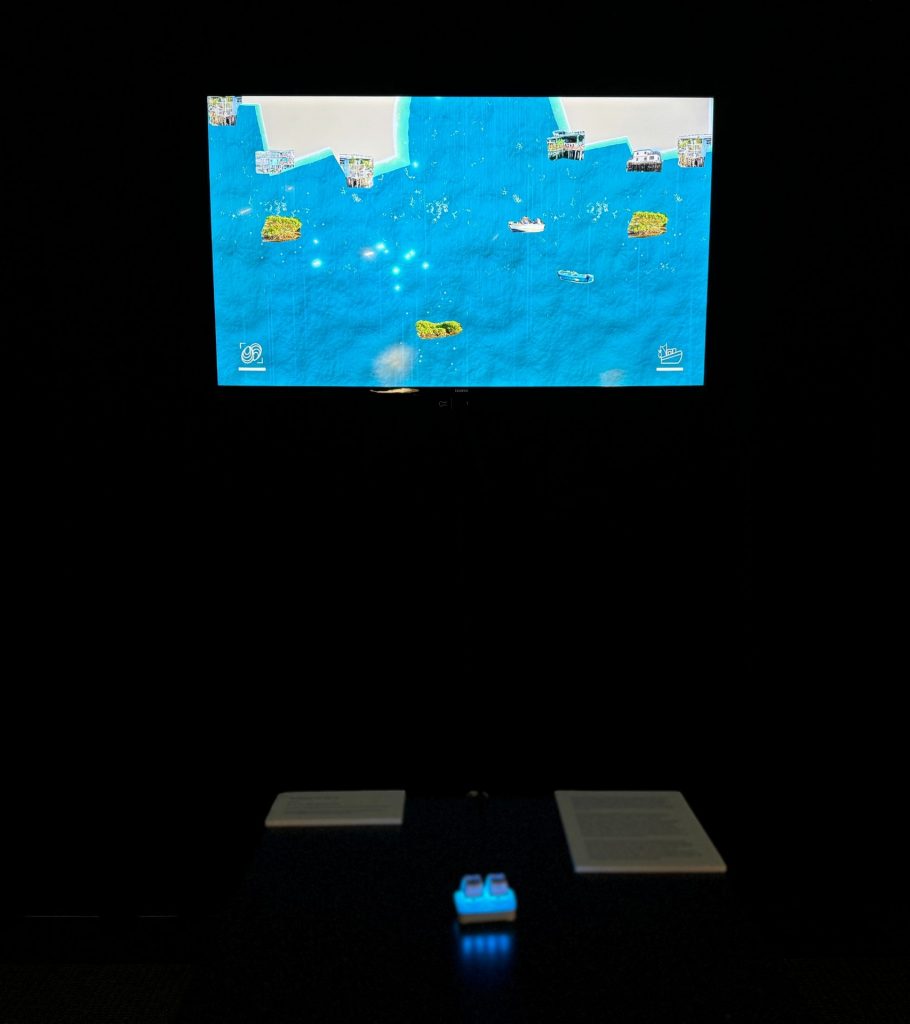 Echoes of Tai O is an interactive game that spans the temporal dimensions of Tai O in Hong Kong. Through game controller interactions, it bridges the virtual and the real. This project is a collaboration with the Hong Kong Red Cross and A Plastic Ocean Foundation Hong Kong. The motivation and inspiration stem from on-site field trips to Tai O and archival research into its history.
Echoes of Tai O is an interactive game that spans the temporal dimensions of Tai O in Hong Kong. Through game controller interactions, it bridges the virtual and the real. This project is a collaboration with the Hong Kong Red Cross and A Plastic Ocean Foundation Hong Kong. The motivation and inspiration stem from on-site field trips to Tai O and archival research into its history.
The artwork features reinforcement learning agents that simulate the virtual Tai O ecosystem, allowing viewers to intervene in the virtual ecosystem. The audience’s interactions have a real-time impact on the virtual ecosystem, which is reflected in the sounds of the disappearing species, the large yellow croaker. This sound represents the way experienced fishermen used to listen for fish movements, relying on the unique “fish stone” in the yellow croaker’s head to detect vibrations. The sounds of the yellow croaker are played in real-time, corresponding to the developments in the virtual ecosystem, in real-world Tai O.
Through this work, the artists aim to highlight how human behavior influences the environment, encouraging people to rethink sustainable living. The game interaction conveys the interconnectedness of all entities, both human and non-human, emphasizing Tai O’s fisheries history, economy, flood disasters, and ecology—encompassing fish, mangroves, oyster castles, and the crustaceans that depend on them—all intricately woven into human activities.
Benefit Game: Alien Seaweed Swarms
Artists: Danlu Fei, Ziwei Wu
Acknowledgment: Kang Zhang, Varvara Guljajeva
Year: 2023 – 2024
Materials: Self-made Game Machine: aluminum alloy, acrylic panel, tinned copper wire; Gashapon Machine: aluminum alloy, glass; Coins: Alloy
 Benefit Game: Alien Seaweed Swarms is a real-time artificial life gameplay installation. The work is inspired by Saccharina Latissima, a seaweed species that can be used both for food and skincare products, which has been extensively cultivated by humans around the world for years to gain profits. However, its morphology is prone to mutation due to environmental changes, and the excessive pursuit of profit by humans can also lead to environmental degradation and the decline of this seaweed population.
Benefit Game: Alien Seaweed Swarms is a real-time artificial life gameplay installation. The work is inspired by Saccharina Latissima, a seaweed species that can be used both for food and skincare products, which has been extensively cultivated by humans around the world for years to gain profits. However, its morphology is prone to mutation due to environmental changes, and the excessive pursuit of profit by humans can also lead to environmental degradation and the decline of this seaweed population.
The artwork features a unique seaweed swarm cybernetic loop, involving an overall system, a sensor, a comparator, a controller, and an effector. The overall system consists of a seaweed swarm system and a symbiotic fungal system, which outputs two types of information in real-time: the profit gained and the “ecological condition”. Humans act as the controller in the loop, with human observation serving as the sensor. The design of the loop places the audience in a pivotal role, encouraging people to observe and reflect on the consequences of their decisions and interactions.
This artwork explores the fragile relationship between human activities and the environment under dynamic climate change, within the context of the “Plantationocene”. It encourages the audience to seek a sustainable ecological balance through an interactive gaming experience.
Empathic Growth
Artists: Ziwei Wu, Danlu Fei, Meng Yang, Jiaqi Shi
Acknowledgment: Jon McCormack, Elliott Wilson, Xi Lei, Australian Centre for the Moving Image (ACMI)
Year: 2024
Materials: Screens, Sensors, GSR Data, GSR Affective Computing Model, Machine Learning on Plants Perception Estimation
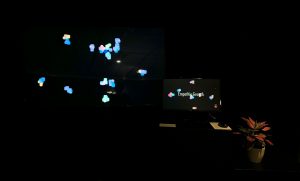 Empathic Growth is an interspecies interactive art installation that explores plant perception from a more-than-human perspective. Grounded in Jakob von Uexküll’s concept of “Umwelt,” the installation recognizes plants as active participants with their own perceptual worlds. By visualizing the biosignals of both humans and plants in a shared environment, Empathic Growth creates a space of shared perception, encouraging participants to reflect on plant agency and fostering empathy between species.
Empathic Growth is an interspecies interactive art installation that explores plant perception from a more-than-human perspective. Grounded in Jakob von Uexküll’s concept of “Umwelt,” the installation recognizes plants as active participants with their own perceptual worlds. By visualizing the biosignals of both humans and plants in a shared environment, Empathic Growth creates a space of shared perception, encouraging participants to reflect on plant agency and fostering empathy between species.
Ursula K. Le Guin’s science fiction Changing Planes delves into various imaginary worlds, or “planes,” each with its unique societies, cultures, and ways of life. Our work draws inspiration from two of these planes. The first features a society that has pushed genetic engineering to its limits, showcasing a human whose genome is partially composed of plants. The second plane presents a society where dreams are shared telepathically, transforming the unconscious mind into a collective experience.
In this installation, the audience can co-create unique sentient hybrids with the plants, exploring shared emotions and consciousness. Specifically, this work employs supervised learning to transform human Galvanic Skin Response (GSR) signals through affective computing, alongside plant signals using perception estimation. Both humans and plants are invited to experience the same sound environment, with the human-plant interactive interface transforming the data into one emotional hybrid form. This hybrid form will evolve into an artificial creature that roams in digital space, exploring collective emotions and consciousness. Through online live-streaming, audiences from other campuses can witness these collective social dreams.
Hidden Incidents of Pet Food
Artists: Ziwei Wu, Danlu Fei, Xiaofu Jin, Burak Korkmaz, You Wen, Yifang Wang
Acknowledgment: Xinyu Ma, Guangda Zhu
Year: 2022 – 2024
Materials: Video
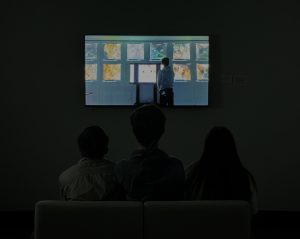 Hidden Incidents of Pet Food is a series of works that integrates artificial intelligence, data visualization, and archival research to reveal the complex and commercialized relationship between humans and pets under the influence of capitalism. The artwork focuses on pet food, representing the significant role of human affection for pets within the service-oriented market economy. The project investigates three chemical elements that affect the health of both pets and humans: Taurine, Melamine, and Pentobarbital.
Hidden Incidents of Pet Food is a series of works that integrates artificial intelligence, data visualization, and archival research to reveal the complex and commercialized relationship between humans and pets under the influence of capitalism. The artwork focuses on pet food, representing the significant role of human affection for pets within the service-oriented market economy. The project investigates three chemical elements that affect the health of both pets and humans: Taurine, Melamine, and Pentobarbital.
The artwork utilizes AI to reconstruct truth and visualization to present real incidents with data, memorializing those overlooked and forgotten lives.
Hidden Incidents of Taurine Deficiency
Artists: Ziwei Wu, Xiaofu Jin, Danlu Fei, Yifang Wang
Year: 2022 – 2024
Materials: DCGAN, Blind Cat Portraits
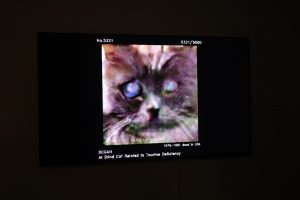 Hidden Incidents of Taurine Deficiency is a digital artwork that combines contemporary art and machine learning to shed light on a relatively unknown yet significant social issue, specifically the taurine deficiency in cat food.
Hidden Incidents of Taurine Deficiency is a digital artwork that combines contemporary art and machine learning to shed light on a relatively unknown yet significant social issue, specifically the taurine deficiency in cat food.
Taurine, an animal protein, is one of the most essential and indispensable elements for cats that can only be obtained from their diet. Despite this, the significance of taurine was not widely recognized by the public until the 1970s, as an increasing number of pets started to suffer from heart disease and blindness after consuming pet food. After systematic clinical studies, they finally found a direct link between Taurine deficiency and cat diseases in 1976. It was, however, not until 1981, that Taurine was first introduced as a standard in pet food quality control, which reflects a huge delay between scientific findings and policy-making.
The artists created the portraits of 6,000 cats who died from taurine deficiency in pet food by training an AI model. The estimation number is related to scientific research. A famous academic article published in Science estimated that at least 1,000 cats die each year in the United States because of insufficient taurine in pet food. This artwork serves as a historical memorial for the forgotten lives of these blind cats.
Behind the Molecules
Artists: Hanlu Ma, Ziwei Wu, Mengying Du, Burak Korkmaz, Xiaofu Jin, Yifang Wang
Acknowledgment: You Wen
Year: 2024
Materials: Incidents Data, News Data, Publication Data, Interactive Web, Screens, Raspberry Pi, Sound
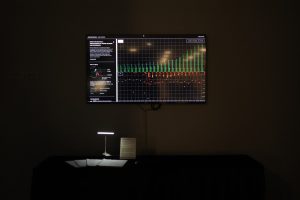 Behind the Molecules is an alternative data visualization platform that critically examines the abuse of chemicals—particularly melamine, taurine, and pentobarbital—in animal feed, pet food, and human food for economic gain. By analyzing historical records dating back to the 1960s, this platform constructs a multi-sensory timeline, using the stock market as a subtle metaphor. Audiences can compare two different facets of the timeline and identify abnormal events within their context, raising questions about the blindness of capital markets. The platform also empowers users to report suspicious incidents of abuse in their lives.
Behind the Molecules is an alternative data visualization platform that critically examines the abuse of chemicals—particularly melamine, taurine, and pentobarbital—in animal feed, pet food, and human food for economic gain. By analyzing historical records dating back to the 1960s, this platform constructs a multi-sensory timeline, using the stock market as a subtle metaphor. Audiences can compare two different facets of the timeline and identify abnormal events within their context, raising questions about the blindness of capital markets. The platform also empowers users to report suspicious incidents of abuse in their lives.
This data-driven narrative sheds light on victims’ voices, which are intentionally marginalized by the food industry. Our work goes beyond charts, leveraging data to archive, memorialize, and advocate for action. It promotes an approach where visualization, as digital artifacts, can serve as powerful tools to challenge informational hegemony.
Hidden Incidents of Melamine Adulteration
Artists: Ziwei Wu, Xiaofu Jin, Danlu Fei, Yifang Wang
Year: 2022 – 2024
Materials: Economy Data, Incidents Data, Commercial Advertising Slogans
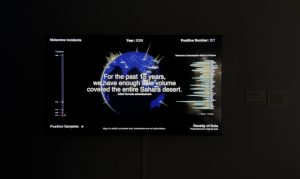 Hidden Incidents of Melamine Adulteration is an artwork that reveals the lives affected by economic and social issues. Melamine adulteration is a long-standing problem in food products, posing significant health risks, including kidney diseases and potential malignancies. Despite its harmful effects, melamine is still being used unethically to falsely increase the protein content in food.
Hidden Incidents of Melamine Adulteration is an artwork that reveals the lives affected by economic and social issues. Melamine adulteration is a long-standing problem in food products, posing significant health risks, including kidney diseases and potential malignancies. Despite its harmful effects, melamine is still being used unethically to falsely increase the protein content in food.
While the 2008 Chinese baby milk scandal is a well-known case, melamine adulteration has been present in foods from other species for a long time. This work compiles incidents and economic data on melamine since the 1980s. The authors aim to increase public awareness of this hidden danger in the food industry by utilizing spatial-temporal visualization to contrast commercial advertising slogans.
Hidden Incidents of Animal Euthanasia
Artists: Ziwei Wu, Danlu Fei, Xiaofu Jin, Burak Korkmaz, You Wen, Yifang Wang
Acknowledgment: Ngaio Richards, Kathleen Wells, Marta Herrero Villar, Robert Jankowski
Year: 2022 – 2024
Materials: Incident Data, 3D AI-generated Mesh, Web-based Interactive Screen, Projector, Sound
 Pentobarbital is a synthetic drug used for euthanasia. Despite its medical legitimacy, pentobarbital also poses significant risks, including secondary poisoning across various species. Collaborating with forensic professionals, the artists have compiled a comprehensive dataset documenting 225 incidents over six months with human-animal interactions (HAIs) categories, spanning from 1967 to 2023. This work transfers the diverse incident data into interactive artwork, highlighting the urgent need for awareness of its dangers.
Pentobarbital is a synthetic drug used for euthanasia. Despite its medical legitimacy, pentobarbital also poses significant risks, including secondary poisoning across various species. Collaborating with forensic professionals, the artists have compiled a comprehensive dataset documenting 225 incidents over six months with human-animal interactions (HAIs) categories, spanning from 1967 to 2023. This work transfers the diverse incident data into interactive artwork, highlighting the urgent need for awareness of its dangers.
The artwork is an experimental case with a new approach that blends objective data visualization and sonification with the subjective interactivity of transforming audience identities. It is a dual-screen interactive installation, with a touch information screen and another roaming screen with a projector. The installation integrates incident data with 2D and 3D network visualization, sonification, and AI-generated 3D models to depict the complex food web among animals related to secondary poisoning incidents. In addition, the artwork explores the concept of “kinship” with HAIs, presenting the relationship of dominance and affection between humans and animals. Through this interaction, audiences shift from passive observers to subjective participants, exercising dominance driven by their affection for the animals, gradually unveiling hidden incidents.

